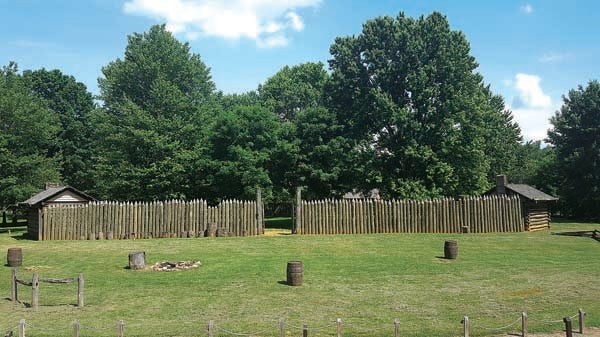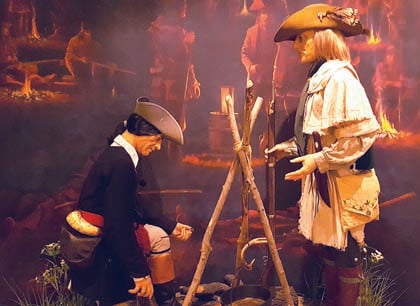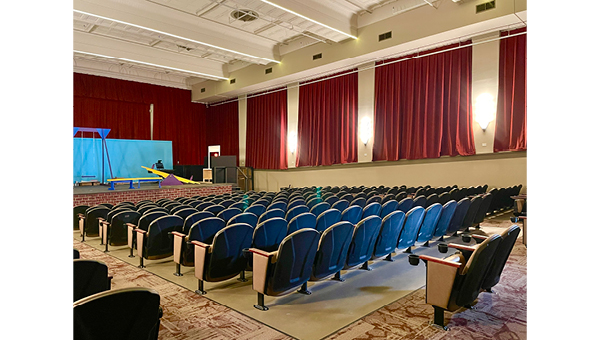Exploring History: Star interns take adventure to Sycamore Shoals State Park
Published 9:21 am Tuesday, June 7, 2016

Photo by Lora Cardwell
Fort Watauga sits on a meadow behind the Visitor’s Center at Sycamore Shoals State Historic Park.
Editor’s Note: This Summer, the Elizabethton Star is being joined by Lora Cardwell and Victoria Perkins as part of East Tennessee State University’s Upward Bound Program for their Career Work Study. Both Lora and Victoria are rising seniors at Cloudland High School. They will be taking part in a variety of activities while participating in the program and they will be sharing their adventures with our readers.
BY LORA CARDWELL AND VICTORIA PERKINS
STAR INTERNS
Our first day at the Elizabethton Star was rather interesting. Our supervisor told us a little about what we are going to be doing here at the Star. For our first photography adventure we were sent out to the Sycamore Shoals Historical Site to do a little “investigating” on some of the people represented there. When we walked inside the museum we were greeted by a park volunteer, regretfully we did not get her name.
We began by walking through the museum, and reading about each person and event. The exhibits included everything from displayed weaponry to a short love story.
When you first enter the museum there is a statue of a Native American’s head, and attached to it is a plaque about him. His name was Dragging Canoe, and how he got this name was rather peculiar.
Dragging Canoe wanted to go with his father, Chief Attakullakulla, who told him that if he carried the canoe he could come along. When people saw this young boy pick up one end of the canoe and begin dragging it they cheered “Tai. Yu gansi, ni Tai, yu Gansi, ni,” which closely translates to “He is dragging the canoe.” His enemies called him Dragon, but sadly it does not say why.
The very next thing you see is a mannequin dressed as an early settler that looks utterly real. A little ways from him is the first case of weapons and some tools, including a wooden arrow with wild turkey feathers as the fletching, spear heads, arrow heads, a gun, and tools made from rock.
On the other side of the hall were two giant stone wheels that were once part of a waterwheel. The wheels were approximately three feet in diameter and a little less than a foot thick.
The next display was a Native American woman farming. She is dressed in bright colors and is working in a field of corn.
After this in a corner of the museum was a large map hanging on the wall in front of which were several different treaties that you could learn more about at the simple click of a button.
Once finished with this, we moved on to another life like display that depicted a woman named Ann Robertson atop the fort wall pouring scalding hot water from washing clothes over onto a Native American crouched below that had gotten close enough to try to set fire to the fort walls. During the siege of Fort Watauga in the Summer of 1776, Robertson organized a bucket brigade of the women at the fort to try to prevent the Cherokee from setting fire to the fort walls. Three years after this Ann went along with her brother to Fort Nashborough where she was the only woman in the Cumberland to receive a land grant in her own name.
Another display case was to the left of this full of goods. It had a scalp that looked like a dream catcher near the center of the case, below it was a little bag near some musket balls that held them, a decorative bag with a gun powder horn, an original English fowler, an axe, a knife, soapstone, and a spiked war hammer.
A favorite story of ours is Bonnie Kate’s. Bonnie Kate’s real name is Catherine Sherrill. In the early hours of July 21, 1776, Catherine was with some other women milking their cows, and minding their business when they were attacked by a band of Cherokee. The women fled to the safety of the fort but Catherine fell behind and was locked out of the fort. This caused her to become desperate in an attempt to find a way in. She had to throw her cap over the palisade to let people know where she was, and then began scaling the wall. Catherine was quoted saying “The bullets and arrows came like hail. It was now leap or die, for I would not live a captive.” John Sevier took Catherine’s outstretched hand. She later became his second wife.
There was a section about The Talbot Family which had two large floor to ceiling photographs one of the family, although is wasn’t the real family it was a reenactment. After the Talbot family was another life like display of Reverend Samuel Doak, who was a part of the Overmountain Men.
The time had come for them to begin their search for Patrick Ferguson and his Tories. Over one thousand militiamen, who were supplied with over 500 pound of Mary Patton’s gunpowder, set out from Sycamore Shoals in pursuit of “Bulldog” Ferguson. They camped at the Sheltering Rock in Roan Mountain. Over 1,500 Patriots departed from Quaker Meadows for the confrontation with Ferguson. Six days later they arrived at King’s Mountain.
The Reverend Doak also founded Doak’s Log College, which was the first institute of learning established west of the Allegheny Mountains south of the River Ohio. The name was later changed to Washington College in honor of George Washington. This was the first institute to bear our first president’s name with his permission.
Down from that exhibit sat two big cauldrons that were used for manufacturing black powder by Mary Patton. The gunpowder was a vital thing to the success of American Soldiers in the battle of Kings Mountain on October 7, 1780. These two kettles/cauldrons were donated by Preston G. Kyte.
Near the end of the self-guided tour there’s an interesting small-scale model of the battle at Kings Mountain. It shows a small camp being surrounded and attacked.
We then proceeded to take a walk outside to the fort to capture a glimpse of the past. When you first walk in you can see a tavern on your left, and continuing around from the left there is an outhouse next to a small cabin. You eventually make your way around to a wood working shop, which has a pile of stacked wood outside.
Then you see the catwalk where they would patrol and make sure that no Native Americans would infiltrate in the night. The catwalk is separated in two by another gate that led to a battlefield.
All in all we had a blast, and would enjoy doing that again. We learned quite a bit.

Photo by Lora Cardwell
This display at the museum depicts a pair of settlers cooking a meal over an open fire.





